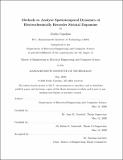| dc.contributor.advisor | Ann M. Graybiel and Helen N. Schwerdt. | en_US |
| dc.contributor.author | Capolino, Giulio. | en_US |
| dc.contributor.other | Massachusetts Institute of Technology. Department of Electrical Engineering and Computer Science. | en_US |
| dc.date.accessioned | 2020-09-15T21:55:12Z | |
| dc.date.available | 2020-09-15T21:55:12Z | |
| dc.date.copyright | 2020 | en_US |
| dc.date.issued | 2020 | en_US |
| dc.identifier.uri | https://hdl.handle.net/1721.1/127384 | |
| dc.description | Thesis: M. Eng., Massachusetts Institute of Technology, Department of Electrical Engineering and Computer Science, May, 2020 | en_US |
| dc.description | Cataloged from the official PDF of thesis. | en_US |
| dc.description | Includes bibliographical references (pages 70-71). | en_US |
| dc.description.abstract | Dopamine neurotransmitter dysregulation is implicated in many neurodegenerative diseases such as Parkinson's and Huntington's diseases and debilitating neuropsychiatric diseases including seizures, addictions, and ADD. The striatum, a cluster of neurons in the subcortical basal ganglia of the brain, has been found to contain both dopamine (DA) receptors and DA axons, which extrasynaptically hold DA neurons which express DA transporters, making it a very interesting site to study. Newly created micro-invasive probes allow for sampling of dopamine and other neurotransmitters at unprecedented spatial densities and distributions, resulting in datasets from multiple pharmacological multichannel dopamine recording experiments. Motivated by the severe health implications of dopamine neurotransmitter dysregulation, and leveraging existing research, this thesis aims to improve an existing framework and workflow, while setting the foundation for future research in this space, exploring unanswered questions at the boundaries of what newly collected datasets can provide. It contributes to the field by providing our research team with a standardized framework such as version control to share progress more flexibly, by improving upon existing dopamine detection algorithms and data-processing workflows, and by exploring through a thorough analysis the unanswered question of spatiotemporal dynamics within the striatum. | en_US |
| dc.description.statementofresponsibility | by Giulio Capolino. | en_US |
| dc.format.extent | 71 pages | en_US |
| dc.language.iso | eng | en_US |
| dc.publisher | Massachusetts Institute of Technology | en_US |
| dc.rights | MIT theses may be protected by copyright. Please reuse MIT thesis content according to the MIT Libraries Permissions Policy, which is available through the URL provided. | en_US |
| dc.rights.uri | http://dspace.mit.edu/handle/1721.1/7582 | en_US |
| dc.subject | Electrical Engineering and Computer Science. | en_US |
| dc.title | Methods to analyze spatiotemporal dynamics of electrochemically recorder striatal dopamine | en_US |
| dc.type | Thesis | en_US |
| dc.description.degree | M. Eng. | en_US |
| dc.contributor.department | Massachusetts Institute of Technology. Department of Electrical Engineering and Computer Science | en_US |
| dc.identifier.oclc | 1192539589 | en_US |
| dc.description.collection | M.Eng. Massachusetts Institute of Technology, Department of Electrical Engineering and Computer Science | en_US |
| dspace.imported | 2020-09-15T21:55:11Z | en_US |
| mit.thesis.degree | Master | en_US |
| mit.thesis.department | EECS | en_US |
